Bahareh Nakisa
Deakin University
Robust Emotion Recognition via Bi-Level Self-Supervised Continual Learning
May 19, 2025Abstract:Emotion recognition through physiological signals such as electroencephalogram (EEG) has become an essential aspect of affective computing and provides an objective way to capture human emotions. However, physiological data characterized by cross-subject variability and noisy labels hinder the performance of emotion recognition models. Existing domain adaptation and continual learning methods struggle to address these issues, especially under realistic conditions where data is continuously streamed and unlabeled. To overcome these limitations, we propose a novel bi-level self-supervised continual learning framework, SSOCL, based on a dynamic memory buffer. This bi-level architecture iteratively refines the dynamic buffer and pseudo-label assignments to effectively retain representative samples, enabling generalization from continuous, unlabeled physiological data streams for emotion recognition. The assigned pseudo-labels are subsequently leveraged for accurate emotion prediction. Key components of the framework, including a fast adaptation module and a cluster-mapping module, enable robust learning and effective handling of evolving data streams. Experimental validation on two mainstream EEG tasks demonstrates the framework's ability to adapt to continuous data streams while maintaining strong generalization across subjects, outperforming existing approaches.
VR Based Emotion Recognition Using Deep Multimodal Fusion With Biosignals Across Multiple Anatomical Domains
Dec 03, 2024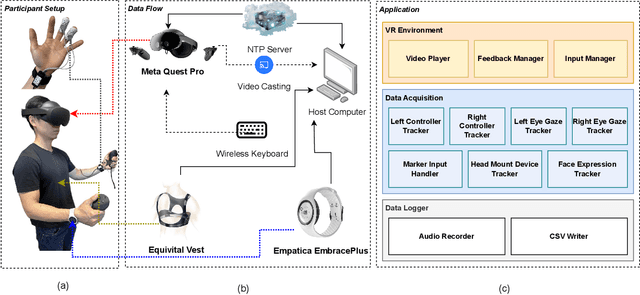
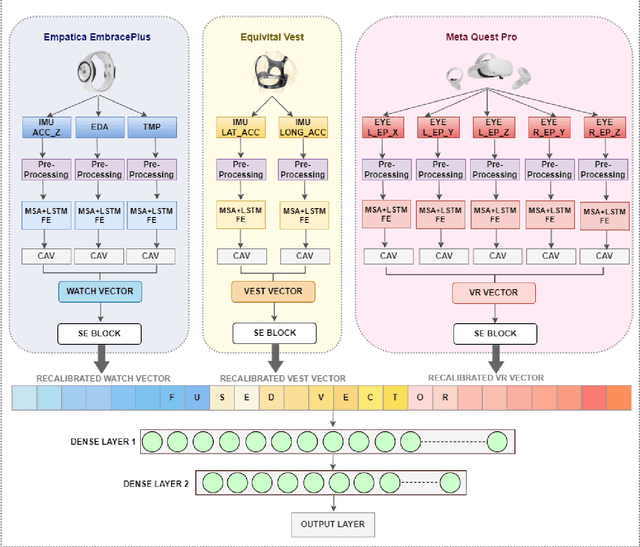
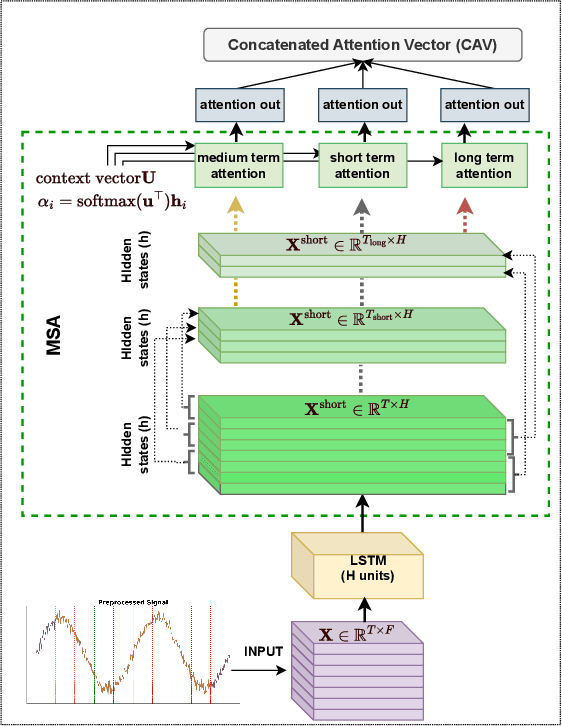

Abstract:Emotion recognition is significantly enhanced by integrating multimodal biosignals and IMU data from multiple domains. In this paper, we introduce a novel multi-scale attention-based LSTM architecture, combined with Squeeze-and-Excitation (SE) blocks, by leveraging multi-domain signals from the head (Meta Quest Pro VR headset), trunk (Equivital Vest), and peripheral (Empatica Embrace Plus) during affect elicitation via visual stimuli. Signals from 23 participants were recorded, alongside self-assessed valence and arousal ratings after each stimulus. LSTM layers extract features from each modality, while multi-scale attention captures fine-grained temporal dependencies, and SE blocks recalibrate feature importance prior to classification. We assess which domain's signals carry the most distinctive emotional information during VR experiences, identifying key biosignals contributing to emotion detection. The proposed architecture, validated in a user study, demonstrates superior performance in classifying valance and arousal level (high / low), showcasing the efficacy of multi-domain and multi-modal fusion with biosignals (e.g., TEMP, EDA) with IMU data (e.g., accelerometer) for emotion recognition in real-world applications.
Adaptive Alignment: Dynamic Preference Adjustments via Multi-Objective Reinforcement Learning for Pluralistic AI
Oct 31, 2024
Abstract:Emerging research in Pluralistic Artificial Intelligence (AI) alignment seeks to address how intelligent systems can be designed and deployed in accordance with diverse human needs and values. We contribute to this pursuit with a dynamic approach for aligning AI with diverse and shifting user preferences through Multi Objective Reinforcement Learning (MORL), via post-learning policy selection adjustment. In this paper, we introduce the proposed framework for this approach, outline its anticipated advantages and assumptions, and discuss technical details about the implementation. We also examine the broader implications of adopting a retroactive alignment approach through the sociotechnical systems perspective.
A BERT-Based Summarization approach for depression detection
Sep 13, 2024Abstract:Depression is a globally prevalent mental disorder with potentially severe repercussions if not addressed, especially in individuals with recurrent episodes. Prior research has shown that early intervention has the potential to mitigate or alleviate symptoms of depression. However, implementing such interventions in a real-world setting may pose considerable challenges. A promising strategy involves leveraging machine learning and artificial intelligence to autonomously detect depression indicators from diverse data sources. One of the most widely available and informative data sources is text, which can reveal a person's mood, thoughts, and feelings. In this context, virtual agents programmed to conduct interviews using clinically validated questionnaires, such as those found in the DAIC-WOZ dataset, offer a robust means for depression detection through linguistic analysis. Utilizing BERT-based models, which are powerful and versatile yet use fewer resources than contemporary large language models, to convert text into numerical representations significantly enhances the precision of depression diagnosis. These models adeptly capture complex semantic and syntactic nuances, improving the detection accuracy of depressive symptoms. Given the inherent limitations of these models concerning text length, our study proposes text summarization as a preprocessing technique to diminish the length and intricacies of input texts. Implementing this method within our uniquely developed framework for feature extraction and classification yielded an F1-score of 0.67 on the test set surpassing all prior benchmarks and 0.81 on the validation set exceeding most previous results on the DAIC-WOZ dataset. Furthermore, we have devised a depression lexicon to assess summary quality and relevance. This lexicon constitutes a valuable asset for ongoing research in depression detection.
Complex Emotion Recognition System using basic emotions via Facial Expression, EEG, and ECG Signals: a review
Sep 09, 2024
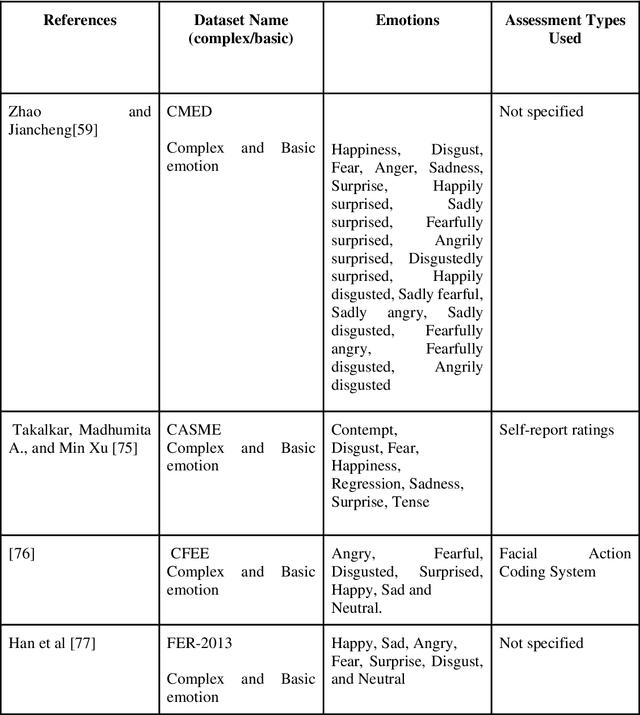

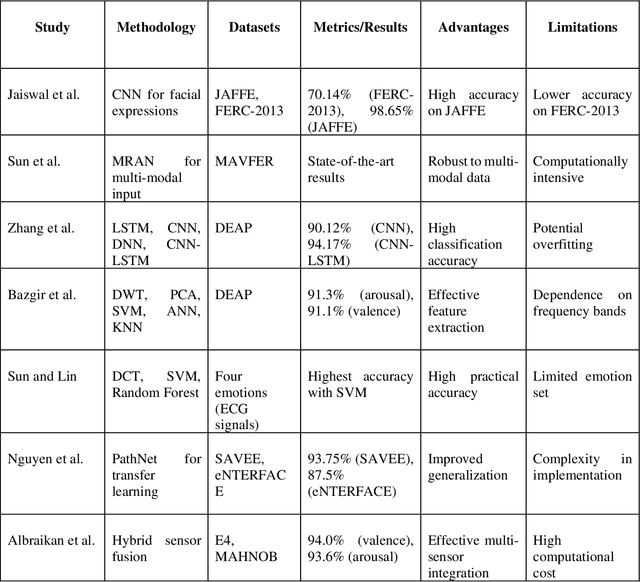
Abstract:The Complex Emotion Recognition System (CERS) deciphers complex emotional states by examining combinations of basic emotions expressed, their interconnections, and the dynamic variations. Through the utilization of advanced algorithms, CERS provides profound insights into emotional dynamics, facilitating a nuanced understanding and customized responses. The attainment of such a level of emotional recognition in machines necessitates the knowledge distillation and the comprehension of novel concepts akin to human cognition. The development of AI systems for discerning complex emotions poses a substantial challenge with significant implications for affective computing. Furthermore, obtaining a sizable dataset for CERS proves to be a daunting task due to the intricacies involved in capturing subtle emotions, necessitating specialized methods for data collection and processing. Incorporating physiological signals such as Electrocardiogram (ECG) and Electroencephalogram (EEG) can notably enhance CERS by furnishing valuable insights into the user's emotional state, enhancing the quality of datasets, and fortifying system dependability. A comprehensive literature review was conducted in this study to assess the efficacy of machine learning, deep learning, and meta-learning approaches in both basic and complex emotion recognition utilizing EEG, ECG signals, and facial expression datasets. The chosen research papers offer perspectives on potential applications, clinical implications, and results of CERSs, with the objective of promoting their acceptance and integration into clinical decision-making processes. This study highlights research gaps and challenges in understanding CERSs, encouraging further investigation by relevant studies and organizations. Lastly, the significance of meta-learning approaches in improving CERS performance and guiding future research endeavors is underscored.
IReCa: Intrinsic Reward-enhanced Context-aware Reinforcement Learning for Human-AI Coordination
Aug 15, 2024



Abstract:In human-AI coordination scenarios, human agents usually exhibit asymmetric behaviors that are significantly sparse and unpredictable compared to those of AI agents. These characteristics introduce two primary challenges to human-AI coordination: the effectiveness of obtaining sparse rewards and the efficiency of training the AI agents. To tackle these challenges, we propose an Intrinsic Reward-enhanced Context-aware (IReCa) reinforcement learning (RL) algorithm, which leverages intrinsic rewards to facilitate the acquisition of sparse rewards and utilizes environmental context to enhance training efficiency. Our IReCa RL algorithm introduces three unique features: (i) it encourages the exploration of sparse rewards by incorporating intrinsic rewards that supplement traditional extrinsic rewards from the environment; (ii) it improves the acquisition of sparse rewards by prioritizing the corresponding sparse state-action pairs; and (iii) it enhances the training efficiency by optimizing the exploration and exploitation through innovative context-aware weights of extrinsic and intrinsic rewards. Extensive simulations executed in the Overcooked layouts demonstrate that our IReCa RL algorithm can increase the accumulated rewards by approximately 20% and reduce the epochs required for convergence by approximately 67% compared to state-of-the-art baselines.
Indoor PM2.5 forecasting and the association with outdoor air pollution: a modelling study based on sensor data in Australia
May 13, 2024



Abstract:Exposure to poor indoor air quality poses significant health risks, necessitating thorough assessment to mitigate associated dangers. This study aims to predict hourly indoor fine particulate matter (PM2.5) concentrations and investigate their correlation with outdoor PM2.5 levels across 24 distinct buildings in Australia. Indoor air quality data were gathered from 91 monitoring sensors in eight Australian cities spanning 2019 to 2022. Employing an innovative three-stage deep ensemble machine learning framework (DEML), comprising three base models (Support Vector Machine, Random Forest, and eXtreme Gradient Boosting) and two meta-models (Random Forest and Generalized Linear Model), hourly indoor PM2.5 concentrations were predicted. The model's accuracy was evaluated using a rolling windows approach, comparing its performance against three benchmark algorithms (SVM, RF, and XGBoost). Additionally, a correlation analysis assessed the relationship between indoor and outdoor PM2.5 concentrations. Results indicate that the DEML model consistently outperformed benchmark models, achieving an R2 ranging from 0.63 to 0.99 and RMSE from 0.01 to 0.663 mg/m3 for most sensors. Notably, outdoor PM2.5 concentrations significantly impacted indoor air quality, particularly evident during events like bushfires. This study underscores the importance of accurate indoor air quality prediction, crucial for developing location-specific early warning systems and informing effective interventions. By promoting protective behaviors, these efforts contribute to enhanced public health outcomes.
Complex Facial Expression Recognition Using Deep Knowledge Distillation of Basic Features
Aug 11, 2023



Abstract:Complex emotion recognition is a cognitive task that has so far eluded the same excellent performance of other tasks that are at or above the level of human cognition. Emotion recognition through facial expressions is particularly difficult due to the complexity of emotions expressed by the human face. For a machine to approach the same level of performance in this domain as a human, it may need to synthesise knowledge and understand new concepts in real-time as humans do. Humans are able to learn new concepts using only few examples, by distilling the important information from memories and discarding the rest. Similarly, continual learning methods learn new classes whilst retaining the knowledge of known classes, whilst few-shot learning methods are able to learn new classes using very few training examples. We propose a novel continual learning method inspired by human cognition and learning that can accurately recognise new compound expression classes using few training samples, by building on and retaining its knowledge of basic expression classes. Using GradCAM visualisations, we demonstrate the relationship between basic and compound facial expressions, which our method leverages through knowledge distillation and a novel Predictive Sorting Memory Replay. Our method achieves the current state-of-the-art in continual learning for complex facial expression recognition with 74.28% Overall Accuracy on new classes. We also demonstrate that using continual learning for complex facial expression recognition achieves far better performance than non-continual learning methods, improving on state-of-the-art non-continual learning methods by 13.95%. To the best of our knowledge, our work is also the first to apply few-shot learning to complex facial expression recognition, achieving the state-of-the-art with 100% accuracy using a single training sample for each expression class.
ECG-Based Driver Stress Levels Detection System Using Hyperparameter Optimization
Jan 01, 2021

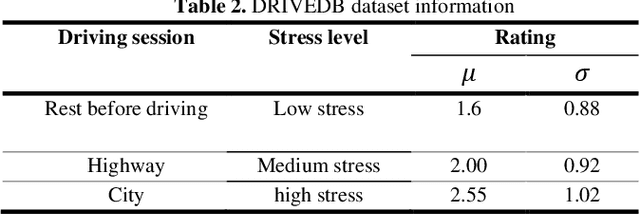

Abstract:Stress and driving are a dangerous combination which can lead to crashes, as evidenced by the large number of road traffic crashes that involve stress. Motivated by the need to address the significant costs of driver stress, it is essential to build a practical system that can classify driver stress level with high accuracy. However, the performance of an accurate driving stress levels classification system depends on hyperparameter optimization choices such as data segmentation (windowing hyperparameters). The configuration setting of hyperparameters, which has an enormous impact on the system performance, are typically hand-tuned while evaluating the algorithm. This tuning process is time consuming and often depends on personal experience. There are also no generic optimal values for hyperparameters values. In this work, we propose a meta-heuristic approach to support automated hyperparameter optimization and provide a real-time driver stress detection system. This is the first systematic study of optimizing windowing hyperparameters based on Electrocardiogram (ECG) signal in the domain of driving safety. Our approach is to propose a framework based on Particle Swarm Optimization algorithm (PSO) to select an optimal/near optimal windowing hyperparameters values. The performance of the proposed framework is evaluated on two datasets: a public dataset (DRIVEDB dataset) and our collected dataset using an advanced simulator. DRIVEDB dataset was collected in a real time driving scenario, and our dataset was collected using an advanced driving simulator in the control environment. We demonstrate that optimising the windowing hyperparameters yields significant improvement in terms of accuracy. The most accurate built model applied to the public dataset and our dataset, based on the selected windowing hyperparameters, achieved 92.12% and 77.78% accuracy, respectively.
 Add to Chrome
Add to Chrome Add to Firefox
Add to Firefox Add to Edge
Add to Edge